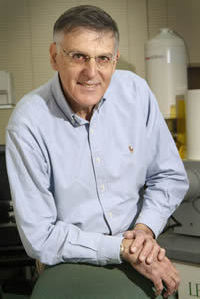Bob Hanson
Welcome to the Chemistry Department Blog. This is the place for Chemistry Majors to get department news and current events.
Friday, October 14, 2011
The King Visits the Chemistry Department
Bob Hanson
Wednesday, October 12, 2011
EMail Received from LeHigh University Chemistry Graduate Program
The Chemistry Department at Lehigh University is accepting graduate applications for the Fall 2012 academic year. The Chemistry graduate program offers cutting edge, multi-disciplinary research opportunities for students in a supportive, small program atmosphere. We offer a competitive stipend ($25,000/year) and full tuition waiver ($13,000/year). We have research opportunities in the traditional areas of chemistry in addition to specializations in surface science, reaction mechanisms, inorganic clusters, materials, biophysical chemistry and nanoparticles. For more information about the Ph.D. program in Chemistry, please click on this link. If you would like to speak to the graduate adviser about our program, please email Professor Rebecca Miller.
The Chemistry Department is participating in the annual College of Arts and Sciences Open House on Saturday, October 29, 2011. The event runs from 10 am – 1 pm with registration beginning at 9:15 am. This is a great opportunity to meet faculty and students in the Chemistry Department, tour the research labs and chat one-on-one with faculty in the department. In addition, all students attending the Open House will receive a graduate application fee waiver (worth $75). Students register for the Open House through this online link. If you can’t attend the Open House event, but would like to visit campus and meet with Chemistry Department faculty at another time, please email Professor Miller.
Tuesday, October 11, 2011
Molecular Pharmacology and Experimental Therapeutics

Not sure that you interested in studying molecular pharmacology?
Not even sure what pharmacology research is all about?
Then just imagine a career that melds the unparalleled thrill of discovering basic biological mechanisms with the excitement of translating those findings into the novel therapies for human diseases—that’s pharmacology. In other words, this is Basic Science on Steroids, where you not only perform cutting-edge basic research that leads to new insights in biology; you see how your discoveries can make a difference. If this appeals to you, consider Mayo Clinic’s Molecular Pharmacology and Experimental Therapeutics Program (MPET), a unique and innovative Ph.D. training opportunity for graduate students looking to contribute to the frontiers of 21st century discovery and medicine.
Extraordinary Mentors
Mayo MPET faculty members actively mentor students by guiding your research project, fostering your intellectual development as a scientist, developing your communication skills, and providing you with career advice so that you can become an independent investigator in academia or industry. They also are world-class scientists whose multidisciplinary research programs integrate across the fields of biochemistry, molecular biology, cell biology, organic chemistry, structural biology, and genetics.
Exceptional Outcomes
Our success in training students is demonstrated by the:
•Tremendous productivity during student training including publications in high-impact journals
•Excellent postdoctoral positions students obtain
•Careers, as leaders in academia and industry that former students are pursuing
•Funding of a highly competitive, peer-reviewed NIH predoctoral pharmacology training grant that peer reviewers described as follows:
"The success of the program (MPET) is evident in the productivity of the trainees while they are in the program and the distinguished careers that they have after they have graduated. This program has numerous strengths, including a heavily funded and engaged cohort of trainers, a comprehensive didactic program, and an administration that has a demonstrated commitment to graduate education … the program is highly effective at training these students and bringing out their best. Along these lines, the MPET is a highly cohesive program with significant evidence of collaboration and numerous events that bring faculty and students together. It appears that MPET students are trained by 'a village' … Overall, this is an excellent training program and enthusiasm for this program is very, very high."
-Peer Review of the National Institutes of Health Predoctoral Training Grant
To Apply
Applications are due by December 1, 2011.
(Be sure to indicate MPET as your first choice!)
http://www.mayo.edu/mgs/phd-admissions.html
To learn more about the MPET program and mentor’s research programs http://www.mayo.edu/mgs/mpet.html
Thursday, October 6, 2011
American Society for Biochemistry and Molecular Biology
Wednesday, October 5, 2011
Israeli Chemist Wins Nobel Prize For Quasicrystals

The 1982 breakthrough fundamentally changed the way chemists look at solid matter, the Royal Swedish Academy of Sciences said.
Scientists used to believe that atoms were arranged inside crystals only in ordered, repeating patterns, Shechtman's work showed that the atoms could be packed in a pattern that did not repeat – a new chemical structure known as a quasicrystal.
NPR's Joe Palca said Shechtman was in the U.S. studying a mixture of aluminum and manganese through an electron microscope when he made the discovery. The microscope allowed him to see how the atoms in the compound were packed together – but the pattern didn't make sense because it seemed to violate the rules of nature by not repeating.
"This was such a fundamental change in what people understood about crystals that it just seemed impossible," Palca said. "So he sent in a paper to a scientific journal, and they basically sent it right back without even ... looking at it at all. But he knew he had something very weird."
All crystals were thought to have rotational symmetry, so that when they are rotated, they look the same. On April 8, 1982, Shechtman first observed crystals with 10 points — pentagonal symmetry, which most scientists said was impossible.